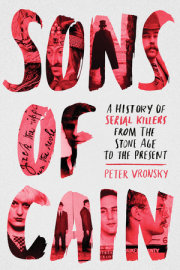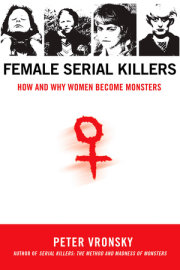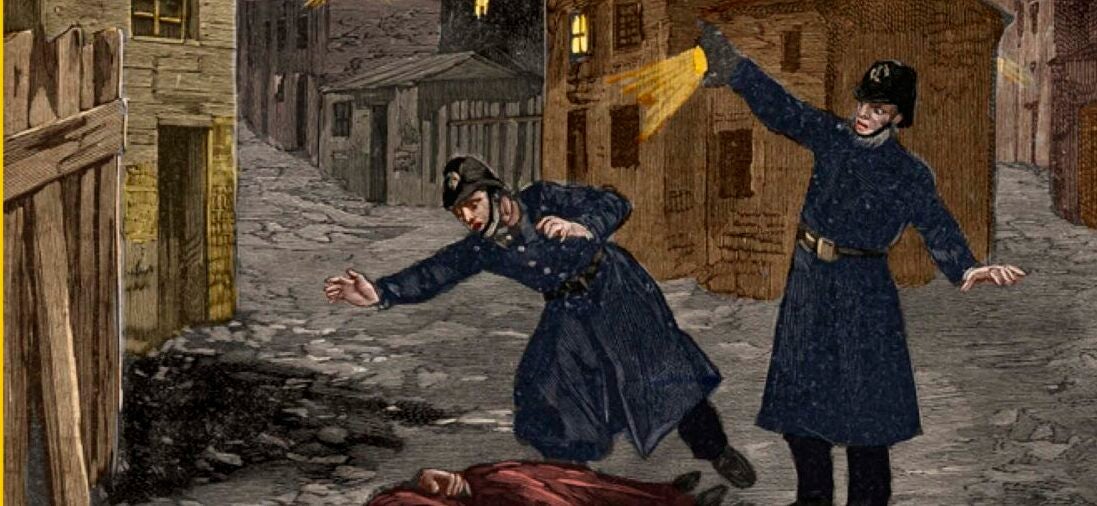Chapter 1
Sons of Cain:
A Brief History of Serial Murder
from the Stone Age to 1930
I am sorry that I am unable to murder the whole damned human race.
Carl Panzram, serial killer
Serial killers have existed since the beginning of humankind, except we did not call them that. Before civilization, humans were an animalistic, murderous, cannibalistic species, driven by a set of instinctual behaviors necessary to survival for hundreds of thousands of years; perhaps for as long as over a million years, depending on how one defines a "human."1
There were at least two distinct species of humans cohabiting the European continent as late as forty thousand years ago: Homo sapiens and Neanderthals (Homo neanderthalensis). Then, in a short span of five thousand years, the Neanderthals suddenly vanished, most likely in a genocidal war of extermination and conquest waged by Homo sapiens in which we wantonly slaughtered the Neanderthal males and raped their women.2
One explanation for our success in the slaughter is that Homo sapiens developed inhibitions against aggression toward members of our own species while the Neanderthals did not.3 There is archaeolocigal evidence that Neanderthals killed one another and cannibalized one another at a higher rate than Homo sapiens did, and in the war between the two species, that gave us the advantage, despite the fact that Neanderthals were physically more powerful and as capable as we were in fashioning stone tools and weapons.4
One scholar, the biblical historian Robert Eisler, argued that humans were at one time a docile vegetarian species, but that the onset of the last Ice Age reduced the availability of edible vegetation in northern regions, and that humans became carnivores out of necessity. At some point even animal prey became scarce, and northern humans clad in animal furs migrated south, attacking, killing, raping and cannibalizing more gentle vegetarian humans dwelling in the temperate climates.5 In his 1951 book Man into Wolf: An Anthropological Interpretation of Sadism, Masochism, and Lycanthropy, Eisler argued that this was both the origin of our werewolf myths and the behavioral roots of modern serial killers. In fact, it is in Eisler's book that the term "serial murder" makes one of its earliest appearances in the English language.6
For over a million years, we were hardwired with a set of reptilian instincts essential to the survival of any species: the "Four-F" evolutionary complex-an unencumbered capacity to fight or flee, feed and fuck. We were all psychopaths, because we had to be. But there is evidence that at the height of our slaughter of the Neanderthals some forty thousand years ago, before we could turn all that aggression on ourselves, we developed an instinctual fear of our own dead-necrophobia. This fear, which was directed particularly toward those closest to us, was a fear that if they were not treated well by us in life, they would rise up from their graves after death and take revenge against us. The evidence is in so-called prehistoric "deviant burials" or "vampire graves" uncovered by archaeologists in which the body was somehow disabled, secured, pinned or mutilated, to prevent it from rising from the dead. The argument is that necrophobia required us to care for the elderly, the sick and the weak rather than abandon them as most species tend to do, which required a degree of social organization and order, a key to future civilizations.7
Then, with the emergence of agriculture some fifteen thousand years ago, we became enclosed by "civilization," and unbridled killing, rape and cannibalism were condemned by newly emergent religious tenets and by secular laws to enforce the instinctual necrophobic prerogative. To ensure an ordered society, humans began to develop social inhibitions against those behaviors. But those inhibitions were artificial. Fifteen thousand years of civilization are hardly enough to extinguish five hundred thousand years of deeply seated murderous instinct in an animal as freethinking and evolved as a human.
Indeed there is no species of human less necrophobic than a serial killer. They not only routinely handle and manipulate corpses with no fear or disgust but can even go into the opposite of necrophobia: necrophilia, a sexual predilection for a corpse. The subject is so taboo that often it is understated in news reporting and true-crime accounts. We forget that notorious serial killers like Jack the Ripper, Ted Bundy and Gary Ridgway were primarily necrophiliacs. Its exact frequency in serial murder cases remains somewhat controversial to this day. On the high end, the Sexual Homicide study by the FBI in the 1980s concluded that "a sexual act" was committed after a victim's death in 42 percent of the 92 victims they studied. In one case, for example, the perpetrator had ejaculated into the knife wound he had made in the victim.8 On the low end, the FBI's Behavioral Analysis Unit concluded in 2014 that "postmortem sexual activity" was present in 11.2 percent of the 329 cases of sexual serial murder perpetrated by a sample of 64 offenders.9 And even in non-serial-murder cases, "opportunistic" acts of necrophilia with a still-warm corpse have been reported often enough.10 It is so taboo that even many serial killers who freely admit and describe their acts torture, rape, mutilation and cannibalism, will hesitate at admitting acts of necrophilia. Thus the wide ranging statistics of its prevalence.
Today we have all sorts of scientific, sociological and psychological terms to describe people with faulty inhibitions on primitive instincts: from simple criminality to more complex notions of psychopathy, sociopathy and antisocial personality disorder. Until very recently, however, we used to describe humans without inhibitions on these instincts as "monsters."
Monstrum: Organized Vampires and Disorganized Werewolves
The word "monster" is derived from the Latin monstrum meaning "an omen or warning of the will of the gods."11 In the premodern past, serial killers were imagined to be supernatural monsters like vampires, werewolves, zombies and ghouls. Even the two primary monsters of Western imagination, the undead vampire and the diabolically transformed werewolf, correspond roughly to the organized/disorganized classification of serial killers used by FBI behaviorists and profilers for decades until it was deprecated by the FBI in 2004.
Like a vampire, the organized serial killer carefully chooses and stalks his victims, charms and seduces them, deceives and persuades them to invite him into their house (as per vampire lore). He is sometimes attractive and takes on a seductive human form. He takes control of the victims' bodies and drains them of their blood in a form of necrophilic intercourse and cold lust. The victims are preserved, not mutilated; the violence is typically measured and coldly controlled.
The disorganized serial killer "blitz" attacks with destructive brute force, like a werewolf. His victim is chosen at random, on impulse. There is no stalking or planning. These killers are repulsively animalistic. They kill and overkill, rape, mutilate, sometimes eat and destroy their victim in an unthinking hot rage and sexual lust. There is no preservation and control of the victim's body, only its destruction or physical consumption.
Five hundred years ago in Europe, serial killers who raped, killed, mutilated and sometimes cannibalized their victims were frequently formally charged as werewolves (lycanthropes) in both criminal and ecclesiastical court proceedings, the records of which survive to this day. Between 1450 and 1650, approximately three hundred werewolf serial killers were executed in Europe, a rate comparable to the nineteenth century and first half of the twentieth.12
Some historians of crime have argued that before the beginning of industrialization around 1750, sexual serial murder of any kind was virtually unknown on the theory that sex crime is a "leisure activity" requiring free time to develop and dwell on sexual fantasies and free movement to act upon them. Prior to the industrial age, anyone other than a wealthy aristocrat was just too busy trying to survive to fantasize about sex and killing, the argument went. Most people were desperately trying to feed themselves and survive invading armies, bandits, revolts and plagues.
But then industrialization drove the dispossessed and impoverished masses into rapidly growing cities, where they became part of a dense pool of anonymous victims to be hunted and killed, like the prostitutes that Jack the Ripper targeted in London's Whitechapel district in 1888. The argument was that before the existence of big cities, tightly knit communities where everybody knew one another policed themselves. A serial killer would be readily identified in such a community, while a migratory stranger would stand out and quickly attract suspicion and attention, in a way they would not in a dense modern city.
We now know, however, that serial killers did exist prior to industrialization, and they appeared in rural communities as often as they did in dense urban environments.
These murders were frequently investigated by ecclesiastical authorities and witch-hunter inquisitors, until the mid-nineteenth century, when policemen, criminologists and forensic psychiatrists supplanted priests, demonologists and church inquisitors in assessing the nature of criminal behavior and madness. We began to recognize serial killers as mortal, not supernatural, but we still did not use the term "serial killer." Individuals charged with offenses like repeated murder, rape, cannibalism and necrophilia were still called monsters, werewolves and vampires by the popular press but were now examined and described by "alienists," as psychiatrists were called back then. They were said to be suffering from monomania, defined as a singular pathological preoccupation or obsession in an otherwise sound mind.
Two schools of criminology emerged. The Italian school, led by Cesare Lombroso (1835-1909), argued that criminals, including serial murderers, were born criminals, "throwbacks" to primitive humans who could be recognized by their brutish, apelike physical features (physiognomy). The rival French school of Alexandre Lacassagne (1843-1924) argued that criminals were not born but made by their environment and upbringing. It was Lacassagne who proclaimed, "Society has the criminals it deserves" (famously paraphrased by Robert F. Kennedy when he was US attorney general). Lacassagne's "environmental" school of criminology prevailed over Lombroso's school when some notorious criminals were found to have refined, gentlemanly features. Unfortunately, in a kind of "throwing the baby out with the bathwater," Lombroso's theory of atavistic return to primitive instincts was thrown out along with his theory of physiognomy. In my previous book, Sons of Cain, I argue for revisiting the theory that serial killer behavior is partly linked to "short-circuited" prehistoric human "Four-F" survival instincts.
Forensic Psychiatry
In 1886, Austrian psychiatrist Richard von Krafft-Ebing (1840-1902) published Psychopathia Sexualis: eine Klinisch-Forensische Studie (Sexual Psychopathy: A Clinical-Forensic Study). In this book he cataloged and categorized a wide range of sexual crimes and disorders reported by psychiatrists. Krafft-Ebing identified a series of paraphilias (literally, "unusual loves"), more commonly known as "sexual deviations" or "perversions," that often motivated and characterized serial sexual murders. One of the most well-known is sexual pleasure in causing pain, for which Krafft-Ebing coined the term "sadism," inspired by the French libertine Marquis de Sade (1740-1814), author of the sexually violent novel The One Hundred Twenty Days of Sodom.
Found almost exclusively in males, a paraphilia is an obsessive predilection for a very particular and statistically unusual type of sex, without which the person cannot be aroused. Paraphilias include specific fantasy scenarios, an erotic fixation on a particular nongenital part of the anatomy (partialism), the sexualization of inanimate objects (fetishes) and a substitution of another act for the sexual one. There are dozens of different paraphilias, some of which are benign if engaged in with a consensual partner, such as:
altocalciphilia (a fetish for high-heeled shoes);
coprophilia (arousal from feces or from being defecated upon by or defecating on a willing partner);
hyphephilia (arousal at the touch of certain things, such as feathers, or a particular textile, such as leather);
masochism (arousal from being dominated, restrained or hurt);
raptophilia (simulated rape with a consenting partner);
trichophilia (fetish for hair).
Other paraphilias are more blatantly transgressive, dangerous and often criminal because their very premise is coercive or destructive:
amokoscisia (desire to slash or mutilate females);
anthropophagy (cannibalism);
erotophonophilia ("lust murder" accompanied by mutilation of the victim before or after death);
flagellationism (sexual satisfaction from whipping or beating a person);
hybristophilia (a desire in a female to partner with a male serial killer, one of the few female paraphilias);
necrophilia (sex with a corpse);
sadism (sexual arousal from dominating, humiliating or causing pain to an unwilling subject).
American Nineteenth-Century Serial Killers
In the United States it has been recently claimed that Herman Webster Mudgett (aka H. H. Holmes), the killer who prowled the 1893 World's Fair in Chicago, was "America's first serial killer."13 He was nothing of the sort.
First, there were many female serial poisoners, like Lydia Sherman, "the American Borgia" (10 victims: 1864-71); Sarah Jane Robinson, "the Poison Fiend" (8 victims: 1881-86); and Jane Toppan, "Jolly Jane" (31 victims: 1885-1901). And there were outlaw profit serial killers preying on frontier settlers and travelers, like the notorious Harpe Brothers in Tennessee in the 1790s or the Bloody Benders and their "murder inn" in Kansas, from 1869 to 1872.
There were also numerous "classic" sexual serial killers pre-H. H. Holmes:
Jesse Pomeroy was arguably America's first known sexual serial killer (1874), and very likely the youngest, at fourteen years old.14 Pomeroy had already been confined in a juvenile facility for a series of nonfatal assaults on young boys, but after his early release he went on to torture and kill two children in separate incidents. Pomeroy was sentenced to life in prison and died in 1932 at the age of seventy-two in the fifty-sixth year of his sentence.
Joseph LaPage, a serial killer who ambushed and mutilated two women in Vermont and New Hampshire in 1874.
Thomas W. Piper murdered two women and a little girl in 1873, battering them to death and engaging in necrophiliac sex acts. A sexton in a Boston church, Piper lured a five-year-old girl into the belfry where he bludgeoned her into unconsciousness with a cricket bat as her family desperately searched for her in the church below. He had planned on keeping her body there to abuse later, but the girl was found and brought home, where she died of her head wounds. Piper was convicted in two of the murders and executed.
The Servant-Girl Annihilator in Austin, Texas, was an unidentified serial killer who murdered, mutilated and posed his victims' corpses with sharp objects inserted into their ears. He killed at least seven women (five African American and two white) between 1884 and 1885.
All these cases occurred prior to both Jack the Ripper in England and H. H. Holmes in Chicago. Moreover, while Holmes was a serial killer, he was only convicted in the murder of an insurance fraud accomplice and his three children. Holmes was paid by a newspaper to make a "confession" in its pages to many other murders, none of which were confirmed. While it is true that he owned and operated a hotel and boardinghouse in Chicago, there was no evidence that it was especially designed as a kill house with gas chambers and corpse chutes or that he even murdered anybody in it.15
Copyright © 2020 by Peter Vronsky. All rights reserved. No part of this excerpt may be reproduced or reprinted without permission in writing from the publisher.








